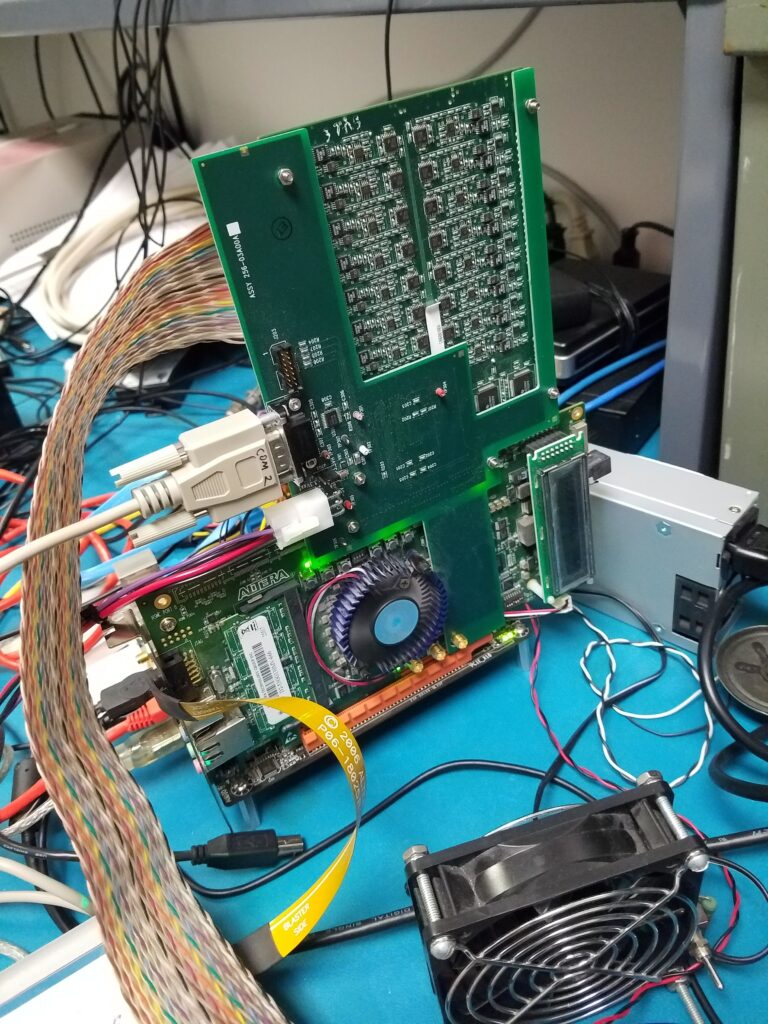Controlling Robots With the Mind
Breakthroughs in Brain-Computer Interfaces
Humans controlling robots with the mind through brain-computer interfaces (BCI) is becoming a reality. MTSI is proud to have played a part in an early technological breakthrough in hardware that may one day shape the future and become part of everyday life – from amputees controlling high-tech prosthetics or implants to improve memory for people dealing with Alzheimer’s, stroke or head injuries.
Donald Woodward, director of the Neuroscience Research Institute of North Carolina, was one of the first to develop multi-neuronal recording techniques, a core part of neural recording implants which capture, amplify, and digitize brain signals. He worked closely with MTSI engineers on two generations of BCI designs using Digital Signal Processing (DSP) to set up the technological platform for those capabilities.
He and his students later made breakthroughs in brain research for detecting motor control functions and to aid motion-challenged people. These systems read, record, and allow us to understand more about our most complex and awe-inspiring organ.
One of the spinoffs of these techniques developed by Woodward and MTSI built upon rat brain research trained a small owl monkey named Belle to control a robot with her mind. As detailed in Scientific American, computers at Duke University read, amplified, digitized, and analyzed information provided by painless electrodes in Belle’s cortex as she manipulated a joystick to move a dot on a T.V. screen to another dot. When she succeeded, she was rewarded with a drop of fruit juice.
Belle loved her task and the delicious rewards and became good at it. But to help the experiment in controlling robots with the mind, the joystick was designed to not always work.
She eventually realized she could think about moving it, and the machine would respond and give her more drops. The signal processing system was able to detect with only 50 to 100 neurons that her neural patterns matched her arm movements. In another room, electronics connected Belle’s brain activity to a multijointed robot arm which turned a mathematical model into instructions to move the arm in just under 300 milliseconds.
Miguel Nicolelis, one of Woodward’s doctoral students, watched.
Belle and the robots moved in synchrony, like dancers choreographed by the electrical impulses sparking in Belle's mind … Belle proved that a BMI can work for a primate brain.
- Scientific American
There was a second robotic arm connected to the internet – and to Belle — that behaved as Bella did nearly 600 miles north at the Massachusetts Institute of Technology. When the robotic arms came to life, the scientists cheered.
Miguel Nicolelis, a Duke University neurobiologist who is pioneering the use of neural implants to study the brain, points proudly to the captured data on the monitor and says: ‘This readout is one of a kind in the world.’
- MIT Technology Review
MTSI engineer Jeff Short, now Vice President of Video Products at MTSI, developed amplifiers and switching circuits that directed different neuron probes into the system to expand the capacity. The technology and research that led to this was originally developed with Nicolelis’ advisor, Woodward, in conjunction with MTSI.
Our engineers designed and manufactured a complete system with 16 amplifiers, filters, and signal processing channels controlled by a Digital Signal Processor (DSP). Up to 64 channels of signal processing could be installed in the custom housing. The application ran on a personal computer which had an oscilloscope-like interface. Cursors could be set to detect one neuron out of a cloud of neurons near the end of Teflon-coated microwires.



Phase II
MITSI also designed a higher speed, larger capacity Phase II system. The data bus speed to the PC was increased by using another DSP connected to the PCI bus. The signal processing and filtering capacity was increased to 64 channels per board.

These types of systems allowed scientists to record 48 neurons spread across five structures that form a rat’s sensorimotor system — the brain regions that perceive and use sensory information to direct movements — with electrodes and a connector embedded in a rat’s skull.
More success in brain-computer interfaces has brought us closer to the goal of controlling robots with the mind in everyday life. Scientists continued working with Belle and discovered more about the animal’s neurons, and made further discoveries with macaque monkeys two years later. There is still a long way to go but this research has not stopped progressing.
The next phase could be human applications for controlling robots with the mind. MTSI recognizes our clients’ and partners’ need for trusted hardware for advanced research – in the institution and the enterprise.
About Dr. Donald Woodward

Donald J. Woodward, Professor and Director of the Neuroscience Research Institute of North Carolina, was one of the first to develop the awake-animal behavioral and multi-neuronal recording technique. He was also the pioneer in the international application and education of this new methodology.
Dr. Woodward developed the first neuronal signal sorting system, the core instrument for multiple channel single-unit recording. In collaboration with his students (John, K. Chapin, Miguel A. Nicolelis, etc.) who are now distinguished scientists, Dr. Woodward has published a series of papers in top journals including Nature, Science, and PNAS.
For more than 40 years, Dr. Woodward worked actively in Neuroscience, and has made multiple contributions in the field of drug abuse, learning and memory, brain development and plasticity, and sensorimotor modulation.
Dr. Woodward has been cited by 12,243 papers, and has 220 scientific publications.

Robert Beckhusen
Robert Beckhusen is a case studies and content marketing editor for Micro Technology Services.
